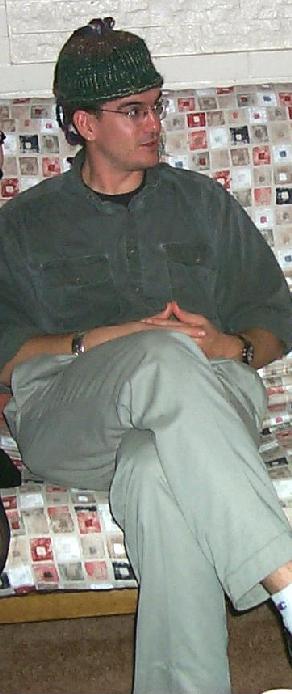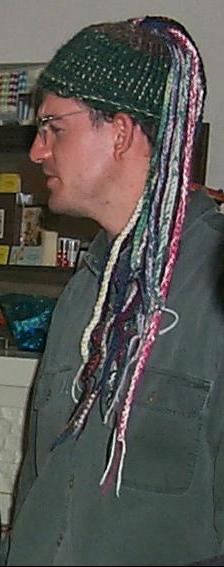Jos loved his work at the WebTV developer site

Jos at the WebTV developer site
as told by Jos's Popster
link to
as told by co-workers
Jos researched and wrote articles and guides at the WebTV developer site.
He loved this work.
Mumsie (his mother) says he was in heaven there.
One of his many projects was organizing and designing
the general appearance of the site.
What could be more fun than swimming around in WebTV,
meeting all the wonderful people there,
learning what they are up to,
and writing about it?
This job gave Jos a license to go wherever
there was a problem (or an opportunity!) and work on it.
And they paid him too!
And the pay kept going up.
"The heist goes on!", he liked to say.
 On his business card he gives himself the title of
Migrant Worker.
It sounds like having your employer pay you to go to college!
How could such a fun job exist?
On his business card he gives himself the title of
Migrant Worker.
It sounds like having your employer pay you to go to college!
How could such a fun job exist?
A big problem faced by the WebTV company is that the market was
|
When this story takes place the internet was new.
Few people had it.
They got it via telephone lines.
WebTV could be,
should be bringing this wonderful new internet thing to everyone, we felt.
|
|
dominated by two giants, Netscape and Microsoft's Internet Explorer.
The WebTV box could do a pretty good job of mimicing those giants
on a household TV,
but unfortunately, there are many important web sites in the world that
do not
look good on a WebTV.
They
could
look good on a WebTV;
but they do not because their author/developers were thinking about computers,
not about television viewers;
and most authors are unaware of the limitations of television.
It was the job of the WebTV developer site to teach authors
to organize their sites
so that they would be acceptable on a television screen.
Jos was to be a teacher and an evangelist.
His patented color picker tool
To his parents, Jos always seemed to be a "people" person.
He did not seem to be a "technology" person.
Only when he went to WebTV did we learn that Jos also liked technology and
he could handle it
too.
One proof of this was that his employer patented his color-picker tool,
and he received $1500 for the patent.
One of Mumsie's favorite photos is the one she took of
Jos and his Popster working together
on a Sunday night on Jos's color picker tool.
Popster could explain this tool, but
Joster's explanation is better (and more fun).
You could go to the WebTV site and try out his
patented color picker tool,
or you could stay right here and try out the
much niftier color picker
that he was developing.
It's fun. It's easy.
Give it a try!
Jos found his color picker to be a real challange.
Beyond the product development challenges,
the American color television standard itself (NTSC)
is a hodgepodge of engineering compromises.
Even at the end, we see him
casting about for help
to best resolve fundamental engineering issues.
He was not one to sweep problems under a rug.
He really did enjoy getting to the bottom of things.
That's a side of his personality that I came to understand more fully
in the last year of his life.
Without an adequate math background,
he did his best to understand Fourier transforms -- he needed them
to explain television and color.
When he "engaged himself" to WebTV 18 months earlier
I had told him not to get his expectations too high,
that WebTV was full of engineers with four year engineering degrees.
He proved my fears unwarranted.
I recall my surprise and delight and his enthusiasm
when he came to explain Huffman coding to me --
and he explained it magnificently.
When he learned that "object coding"
was possible in Javascript he immediately began modifying
his colorpicker to introduce it.
To raise author awareness of issues,
they set up electronic message boards called "developer forums".
Jos often posted answers to questions raised there.
To help you scan the messages,
I got copies of the three forums,
and truncated each copy after its last posting related to Jos.
There you can read Jos's last public technical remarks.
You can also read the last public words to Jos by his brother Martin.
Please browse these developer forums.
Thoughts on strategy

 Jos enjoyed doing a good job.
Not only in writing good articles,
but also in supporting
the company's product and its market position.
In a memo found in Popster's computer we see
how he envisioned
building his team.
His boss Heather
says that Jos and she and Joel had many long discussions
about how they could more effectively handle developer relations
with limited resources.
Jos enjoyed doing a good job.
Not only in writing good articles,
but also in supporting
the company's product and its market position.
In a memo found in Popster's computer we see
how he envisioned
building his team.
His boss Heather
says that Jos and she and Joel had many long discussions
about how they could more effectively handle developer relations
with limited resources.
One day Jos came to me [his Popster] all excited about something
that he called "home-baked cookies."
I think this was a type of cookie that he was baking
that would solve a pesky problem at WebTV.
It seems that some of their customers were guilty of abusive behavior.
There might be no way to control all forms of abusive behavior,
but Jos had found a way to end abusive behavior of WebTV customers
against other WebTV customers.
He called it "a robust exclusionary technique",
a way that a site could block other specified WebTV users
from accessing their site.
I don't know if Jos's home-baked cookies are fully baked yet
or if they are still in the oven.

Jos's desktop
Let us dig around on Jos's desktop and see what else we can find:
- Bugflash.
This document Jos pulled together
to teach new folks on the team
how to use this internal bug tracking tool.
If you have a little patience,
you'll uncover some typical Jos language
and humor in this internal training doc.
A Bug is "Active" if it is in any of the following states:
Pending, Open, Investigate, Fixed, Built, Staged.
A bug is "Not Active" if it is in any of the following states:
Closed, Duplicate,
Unsolved, WillNotFix, or
NAB: Not A Bug. Example--
"There are frames on the developer site!"
This is a design decision, not a bug.
Hence,
this bug would be NAB'ed.
A request to remove the frames from developer.webtv.net is
really a "feature request".
- Josie.
Jos and Heather would work from these notes
to brainstorm and jot down the possible next pieces
Jos would write or tools he would work on.
Whither WebTV?
It was quite a surprise to Jos when one of the three company founders resigned.
What was going to happen?
Would he found another company?
What would it do?
Who would he want to bring along?
Would any of Jos's friends be leaving to join?
Would Jos himself be invited?
"Don't worry, Mumsie, I've got irons in the fire."
We don't know what they were,
but he did bring
his resume up to date.
Ultimately, what would have been Jos's chosen career?
Jos had often gone in directions Popster and Mumsie had not predicted.
We didn't expect him to turn into a computer coder.
Much as he seemed to get into coding
he had reason to move on.
When some of his friends left WebTV,
maybe he'd have
gone along.
But maybe he would have gone into film making in Hollywood.
Or maybe he would become a writer and teacher like his father.
More likely he would be doing something none of us can guess.
We see no reason
why he could not some day
have become the President of the United States.
(We've been reminded that he had already gotten
disillusioned with Washington,
but that's what they all say.)
But, he really did love his job tech writing at WebTV and he might
have stayed much longer.
The entire developer.webtv.net site is content that Jos worked on
(except the Interactive TV section).
When Jos first joined the group at the developer site
he wrote flamboyant articles
(see
"he coulda got fired"),
articles that he signed.
As his responsibilities grew,
his articles were more "corporate" and unsigned;
and his humor became more subdued.
Although he researched and wrote many articles wholly
by himself, he sometimes rewrote articles of earlier authors.
Starting from
Jos's resume,
we came up with the list below.
A lot of work done in six months!
-
What is the Resolution of a TV Screen?
In Jos's estimation, this article is the first of his
greatest hits.
-
Introduction to WebTV - Jos reworked this older document.
Not his favorite piece.
-
WebTV Development Checklist -
"Use the checklist as a way to make sure your site
functions well on WebTV..."
-
Viewer Guide
-
Jos rewrote this complicated document.
-
Color Picker
- Jos came up with the idea of the color picker and built it.
Heather's "menstral" story was from here.
Jos was reworking the code and having a tough day of it
- sorta hit a road block.
So he was all cranky that day.
Then he came in the next morning - bright eyed and bushy tailed
and said he had figured out he had just been menstral about the whole thing
- but that he was ready to tackle it again.

-
Overcoming Blurry Screens with JavaScript -
"Television's basic technology, now over 100 years old, was never meant
to display the finer details of Web graphics." -
Jos's idea.
A lot of research went into it -
along with a meeting with company founder Steve Perlman
to get to the bottom of it.
-
Cross-Platfrom Color for PCs and TVs "Choosing
the right colors and combinations of colors to make your Web
page look good on personal computer monitors and also on TV displays
is a challenging task."
-
Avoiding Color Distortion on Television -
"For something that we all thought we had mastered back in kindergarten,
colors are actually very complex..."
-
Using a browser sniffer to detect WebTV -
"A browser 'sniffer' or detector is a useful tool for customizing your Web
site to various categories of users."
-
Does WebTV Support?
- This is a very important article for WebTV developers.
Jos and Heather worked out how they could rework
this document to be more practical and direct.
It is a critical piece on the site.
-
WebTV HTML Reference Guide
- This was one of the first docs that Jos and Heather had to tackle.
It's a behemoth.
Together they
nailed down the architecture; and Jos updated the content.
-
Forms on WebTV: Function follows form
"In my time at WebTV,
I have frequently been asked to figure out why
the HTML forms on a certain site weren't working properly
on a WebTV browser."
The title alone tells us that Jos wrote it.
-
WebTV frames things a different way
"Frames-based pages can work great for WebTV users,
but a few eccentricities can sneak up on an unwary developer,
rendering some pages dramatically different
than what the author intended."
With a pun in the title,
the title again tells us that Jos wrote it.
-
Making Spliced Images Work
"In the ongoing battle against slow download speeds,
many Web developers splice large images into several smaller pieces
and then re-assemble them into an HTML table.
Image splicing is a popular technique and has many advantages."
- This is an important doc because
many developers have this problem on WebTV.
Jos explains what is really happening.
He worked with Kristi Taylor on this one.
-
Seamless Image maps
"Image maps can be confusing for novice Web surfers.
Many users don't realize that certain parts of an image map
can be clickable while others are not."
- Jos liked the little graphics in this one.
-
WebTV Javascript Guide
"In order to help developers create scripts that run on all platforms,
the WebTV browser attempts to be compatible with Netscape's,
Microsoft's, and ECMA's versions of JavaScript.
However, full compatibility with all the standards
is impossible due to..."
This doc is the big daddy and
a bit of a headache since WebTV supports Javascript uniquely.
Jos had to work with Cary Clark and Scott Sanders on this quite a bit.
A tough one to nail down and ever changing.
-
HTTP docs: user agent strings
"Who do you want to be today?
Only your user-agent knows for sure."
-
WebTV Proxy Server Q&A
"Like AOL users, WebTV subscribers access the Internet through a
"proxy server".
Proxy servers intercept traffic between servers and clients,
"tweak" or cache it, then pass it along."
-
Why don't WebTV users see my 404:
The Gentle Deceit of HTTP Response Headers.
Let's say you ask me a question, "Do you have any bananas?"
return to the life of Jos





 On his business card he gives himself the title of
Migrant Worker.
It sounds like having your employer pay you to go to college!
How could such a fun job exist?
On his business card he gives himself the title of
Migrant Worker.
It sounds like having your employer pay you to go to college!
How could such a fun job exist?

Jos enjoyed doing a good job.
Not only in writing good articles,
but also in supporting
the company's product and its market position.
In a memo found in Popster's computer we see
how he envisioned
building his team.
His boss Heather
says that Jos and she and Joel had many long discussions
about how they could more effectively handle developer relations
with limited resources.

